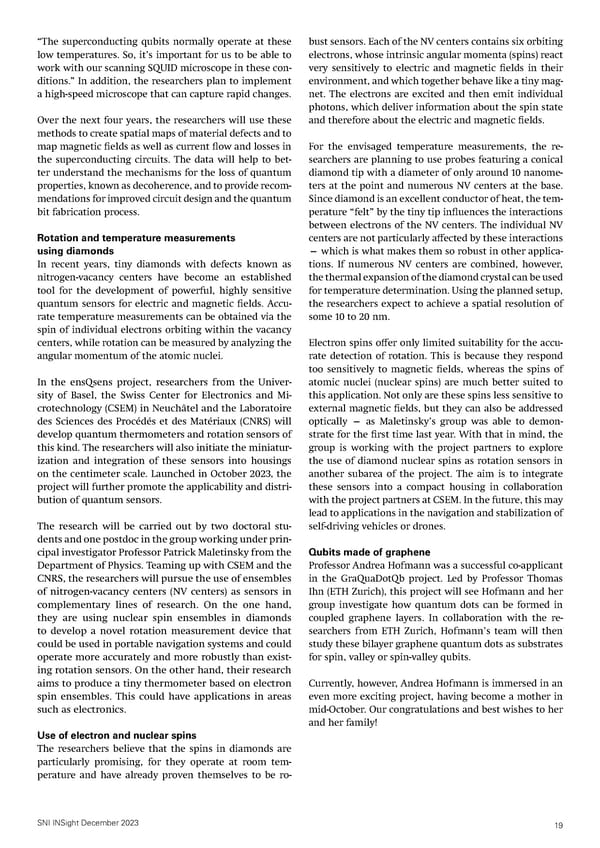“The superconducting qubits normally operate at these bust sensors. Each of the NV centers contains six orbiting low temperatures. So, it’s important for us to be able to electrons, whose intrinsic angular momenta (spins) react work with our scanning SQUID microscope in these con- very sensitively to electric and magnetic 昀椀elds in their ditions.” In addition, the researchers plan to implement environment, and which together behave like a tiny mag- a high-speed microscope that can capture rapid changes. net. The electrons are excited and then emit individual photons, which deliver information about the spin state Over the next four years, the researchers will use these and therefore about the electric and magnetic 昀椀elds. methods to create spatial maps of material defects and to map magnetic 昀椀elds as well as current 昀氀ow and losses in For the envisaged temperature measurements, the re- the superconducting circuits. The data will help to bet- searchers are planning to use probes featuring a conical ter understand the mechanisms for the loss of quantum diamond tip with a diameter of only around 10 nanome- properties, known as decoherence, and to provide recom- ters at the point and numerous NV centers at the base. mendations for improved circuit design and the quantum Since diamond is an excellent conductor of heat, the tem- bit fabrication process. perature “felt” by the tiny tip in昀氀uences the interactions between electrons of the NV centers. The individual NV Rotation and temperature measurements centers are not particularly a昀昀ected by these interactions using diamonds — which is what makes them so robust in other applica- In recent years, tiny diamonds with defects known as tions. If numerous NV centers are combined, however, nitrogen-vacancy centers have become an established the thermal expansion of the diamond crystal can be used tool for the development of powerful, highly sensitive for temperature determination. Using the planned setup, quantum sensors for electric and magnetic 昀椀elds. Accu- the researchers expect to achieve a spatial resolution of rate temperature measurements can be obtained via the some 10 to 20 nm. spin of individual electrons orbiting within the vacancy centers, while rotation can be measured by analyzing the Electron spins o昀昀er only limited suitability for the accu- angular momentum of the atomic nuclei. rate detection of rotation. This is because they respond too sensitively to magnetic 昀椀elds, whereas the spins of In the ensQsens project, researchers from the Univer- atomic nuclei (nuclear spins) are much better suited to sity of Basel, the Swiss Center for Electronics and Mi- this application. Not only are these spins less sensitive to crotechnology (CSEM) in Neuchâtel and the Laboratoire external magnetic 昀椀elds, but they can also be addressed des Sciences des Procédés et des Matériaux (CNRS) will optically — as Maletinsky’s group was able to demon- develop quantum thermometers and rotation sensors of strate for the 昀椀rst time last year. With that in mind, the this kind. The researchers will also initiate the miniatur- group is working with the project partners to explore ization and integration of these sensors into housings the use of diamond nuclear spins as rotation sensors in on the centimeter scale. Launched in October 2023, the another subarea of the project. The aim is to integrate project will further promote the applicability and distri- these sensors into a compact housing in collaboration bution of quantum sensors. with the project partners at CSEM. In the future, this may lead to applications in the navigation and stabilization of The research will be carried out by two doctoral stu- self-driving vehicles or drones. dents and one postdoc in the group working under prin- cipal investigator Professor Patrick Maletinsky from the Qubits made of graphene Department of Physics. Teaming up with CSEM and the Professor Andrea Hofmann was a successful co-applicant CNRS, the researchers will pursue the use of ensembles in the GraQuaDotQb project. Led by Professor Thomas of nitrogen-vacancy centers (NV centers) as sensors in Ihn (ETH Zurich), this project will see Hofmann and her complementary lines of research. On the one hand, group investigate how quantum dots can be formed in they are using nuclear spin ensembles in diamonds coupled graphene layers. In collaboration with the re- to develop a novel rotation measurement device that searchers from ETH Zurich, Hofmann’s team will then could be used in portable navigation systems and could study these bilayer graphene quantum dots as substrates operate more accurately and more robustly than exist- for spin, valley or spin-valley qubits. ing rotation sensors. On the other hand, their research aims to produce a tiny thermometer based on electron Currently, however, Andrea Hofmann is immersed in an spin ensembles. This could have applications in areas even more exciting project, having become a mother in such as electronics. mid-October. Our congratulations and best wishes to her and her family! Use of electron and nuclear spins The researchers believe that the spins in diamonds are particularly promising, for they operate at room tem- perature and have already proven themselves to be ro- SNI INSight December 2023 19
 SNI INSight December 2023 Page 18 Page 20
SNI INSight December 2023 Page 18 Page 20